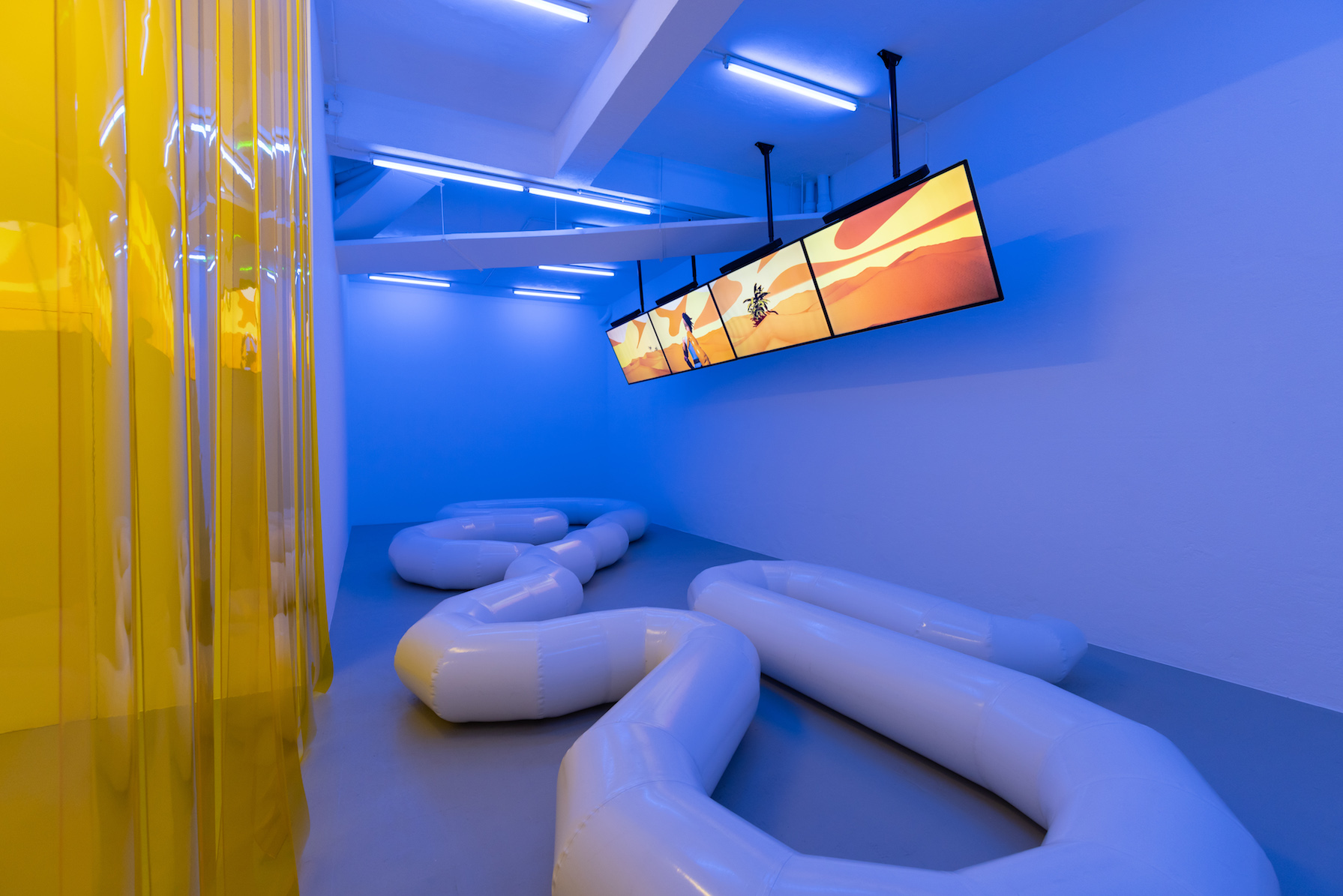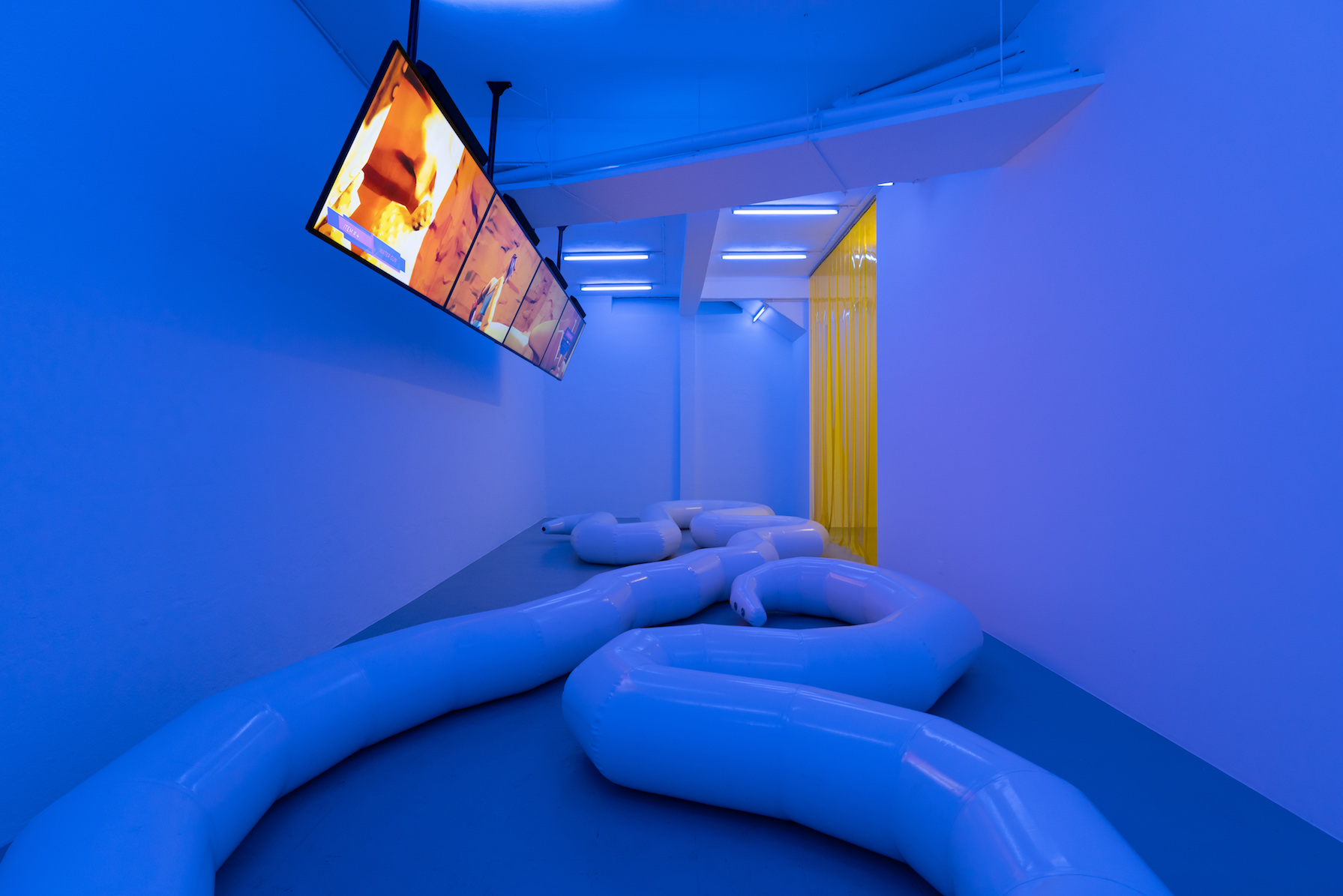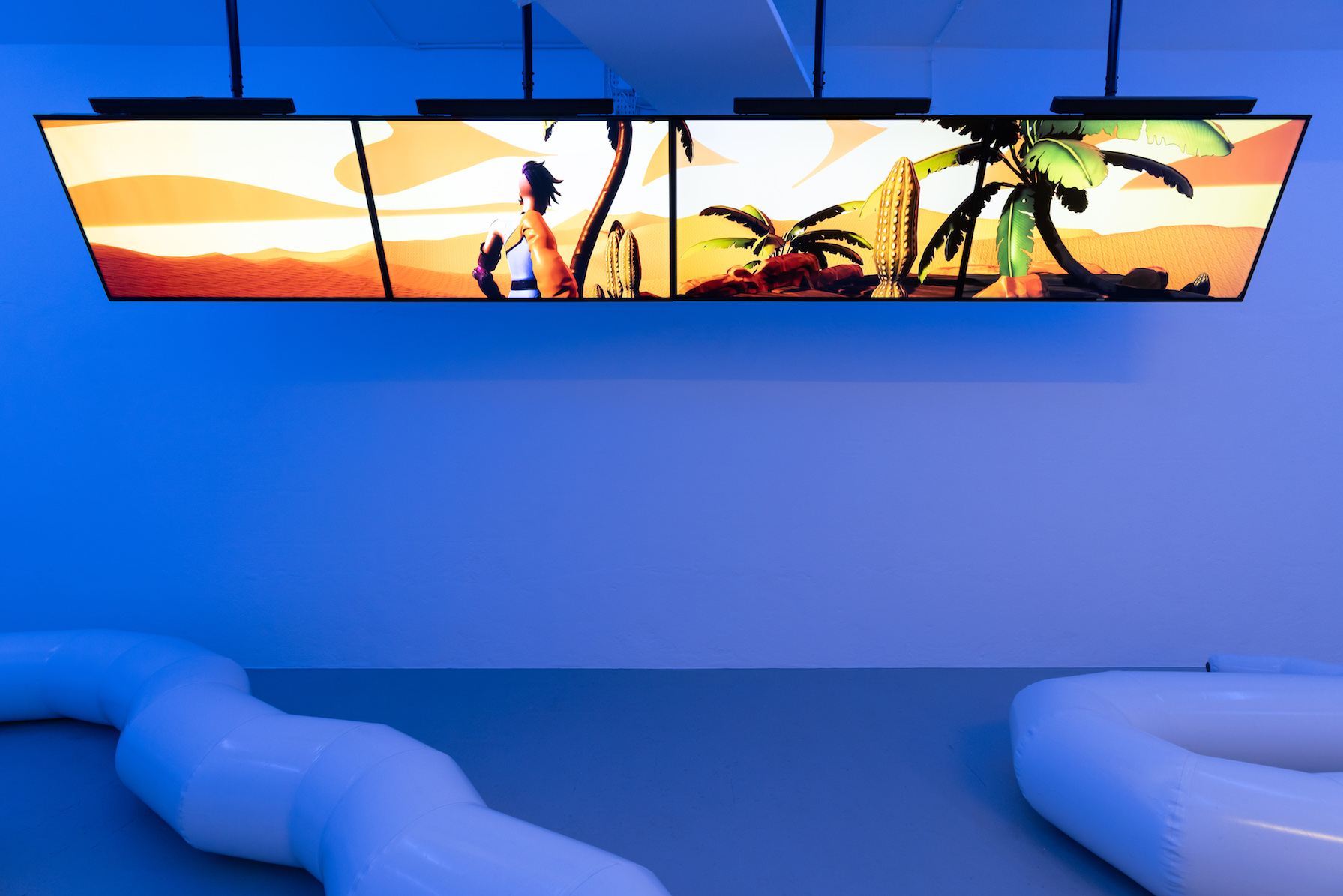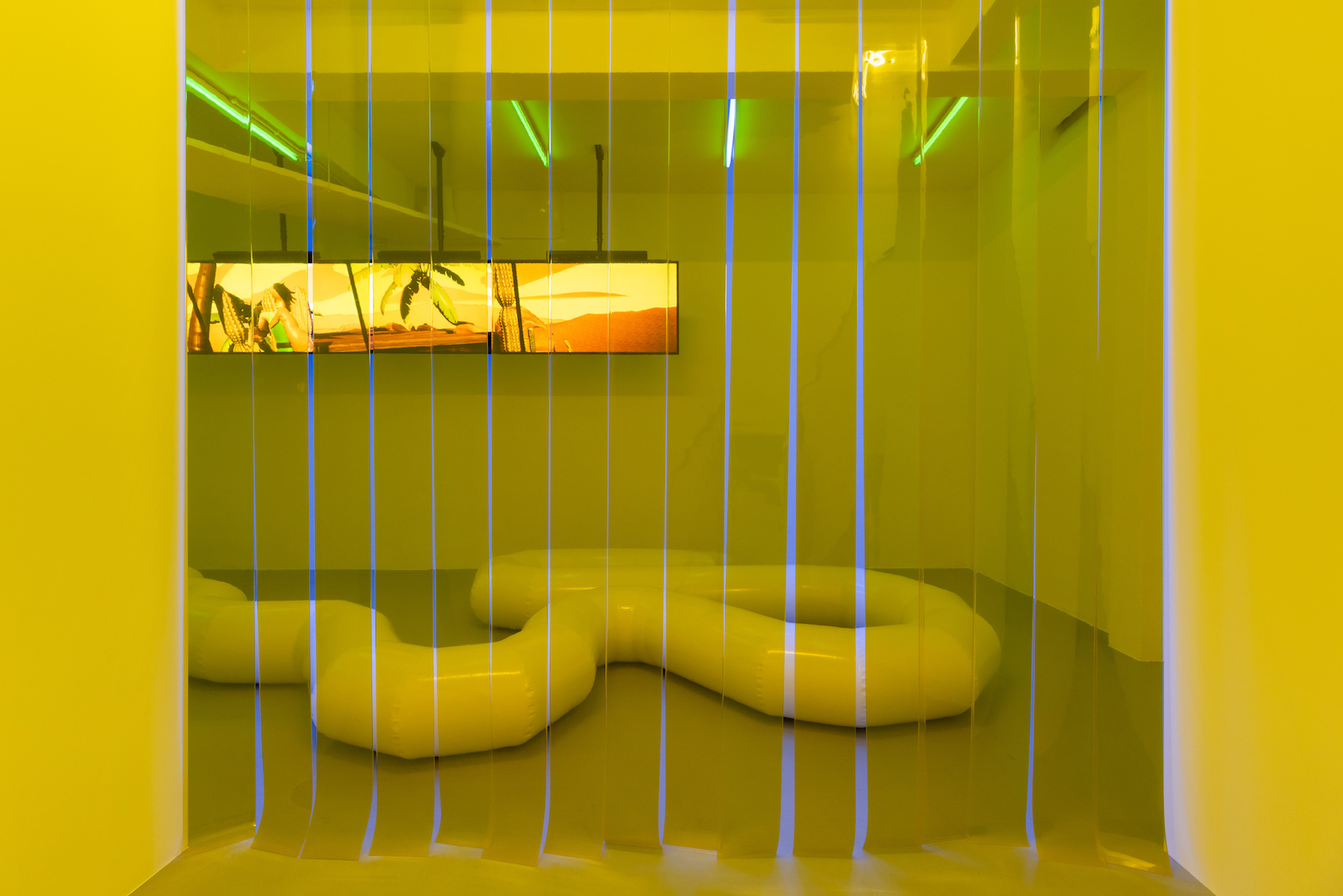Sara Sadik: Dors petit Dors

Sara Sadik’s Dors petit dors at Kunsthalle Lissabon is a hypnotic, empowering meditation on overcoming a difficult childhood. The multimedia installation is something of a performance taking place partly in the virtual world through a video installation of a game walk-through, where the audience are passive observers, and partly in the dream-like physical space of the gallery in yellow and blue. Taking its name from the homonymous song by the French rapper JUL, a lullaby for the children whose realities don’t fit the “happy family” image, the exhibition set up mirrors the semi-awake state of listening to a lullaby by placing the viewer between the physical and the virtual reality.
Dors petit dors saw a transformation of the gallery into a world of plastic, going as far as embracing the smell of new plastic, which permeates the space. The gallery area is cut off from the rest of the world with a thick, half-yellow, half-transparent plastic curtain, popular at some point in the early 2000s. Behind the curtains, in a blue-lit space, four screens show the walk-through video, which you can watch from a gigantic, blown-up white plastic worm that takes up the space disproportionately. In the world of the video, most apparent is the sound of plastic rubbing against plastic as the video follows a feminine-androgynous cyborg character with one arm in plastic and the other in metal on a run through an orange desert. Once in a while, the seemingly eternal orange sand hills are interrupted by an oasis, upon which the surrounding sound shifts to a calm melody. This is where the protagonist finds their old, lost toys—seemingly the goal of the game. After each find, a brief text appears on the screen, as exemplified by the first one: “ITEM #1 CAR TOY / Remember the first car you had? I know that you lost it one day, but don’t worry, it will stay here forever.”
Acting as a tool to relive and re-envision bittersweet memories of childhood, the game presents a future where childhood worries are resolved. Just as fairytales use storytelling tools to reframe experiences and therapy uses speech to do the same, Dors petit dors uses the multimedia storytelling tool of a video game to reframe traumatic experiences from a futurist perspective and, at the same time, share them with a broader audience. This is crucial, since these kinds of childhood stories are often either kept out of sight, fetishised, or shown as hopeless. The cyborg character is instead an image of strength as they navigate the futurist landscape with ease. Most of it may be desert and the oases few—reflecting JUL’s phrase in the Dors petit dors song “there’s nothing to do outside,” the socioecological crisis we live in, and a surreal geographical memory of the Maghreb—but the protagonist’s movements are purposeful; and when the animation reveals the character’s face for a second, there's a smile it.
Sadik has become known for what is somewhat controversially labelled beurcore, a kind of Afrofuturism which in her bios is described as “the essence of North African-descended youth living in French suburbs culture.”[1] In Dors petit dors, this is tied thematically to the song it takes its title from and and the desert landscape, as well as the need to create an image of hope by showing an empowered future. This is further strengthened by the image of the cyborg, which can be read as a reference to Donna J. Harraway’s understanding of the cyborg as a boundary-free method of empowerment and a tool to articulate realities otherwise difficult to articulate.[2] The show offers thereby an uncanny healing memory that responds to the lyrics of JUL’s "Dors petit dors" which if paraphrased reads: it will all be alright, just sleep; if you stay strong, things will be alright. In light of the socioeconomic crisis that the recent rioters in France speak of and the increasingly desperate situation of many children (and adults) in working-class, immigrant areas of Portugal, the show is also a much-needed and rarely televised resistance to a reality without adopting top-down clichés of depravation.
Instead of dwelling on misfortune, both JUL’s song and Sadik’s exhibition highlight strength and possibilities. An excerpt of JUL’s lyrics read, “Sleep little one, sleep … you’ve got to get through it and stay strong / Some of us have lived without daddy / And I’m so glad you’re here … Papa will take care of the problems, mama will take you to school / Sleep little one, sleep, / Tonight daddy will sleep in his cell / He’ll have your photo on the wall to remind him of the past.” They underline the fact that love is still there, that if you keep strong, things will get better; the problems will be taken care of, and daddy still has that photo of you on the wall, even in his cell. Similarly, Sadik’s Dors petit dors shows a fictional world where the toys are memories and the troubles of the childhood long gone. As the exhibition text reads: “Not all lullabies are necessarily sweet, as not all dreams are pure and enchanted.” For most of us, hope lies not in fairy-tales or middle-class-focused TV shows but in finding the strength needed to build new possible futures. Even if the cyborg desert future may not seem to be optimal to most, it feels comforting, relatable and above all realistic—a surreal mirror of past, present, and future that reassures us that all worries can be overcome.
Maria Kruglyak is a researcher, critic and writer specializing in contemporary art and culture. She is editor-in-chief and founder of Culturala, a networked art and cultural theory magazine that experiments with a direct and accessible language for contemporary art. She holds an MA in Art History from SOAS, University of London, where she focused on contemporary art from East and South East Asia. She completed a curatorial and editorial internship at MAAT in 2022 and currently works as a freelance art writer.
Proofreading: Diogo Montenegro.




Sara Sadik: Dors petit Dors. Exhibition views at Kunsthalle Lissabon, Lisbon, 2023. Photos: Bruno Lopes. Courtesy of the artist and Kunsthalle Lissabon.
Notes:
[1] “Artists in Residence: Sara Sadik”, TRI-ANGLE FRANCE. The basis of Sadik’s work with beurcore is her own background as part of the Maghrebi diaspora in Marseille. She describes her own entry into beurcore and art as follows: “I remember I typed into Google ‘contemporary art banlieue.’ I wanted to know if it existed. I found the work of Mohamed Bourouissa and I thought, ‘What the fuck! It does exist!’ It could have been my father in those photographs — not my father in Morocco wearing a traditional outfit, but my father in my own neighborhood. Something switched in me. I realized it was possible to make art telling my own story without having to invent a new life. From that point onwards I was producing so much: working all day, writing video, shooting video. Seeing Bourouissa’s work made me realize, ‘Okay, it’s legitimate for me to make art.’” Quoted from Ben Broome, ‘Show Them, Tell Them, Don’t Explain.’ A Conversation with Sara Sadik," Flash Art, 28 June 2023.
[2] Donna J. Harraway, A Cyborg Manifesto (1985).
